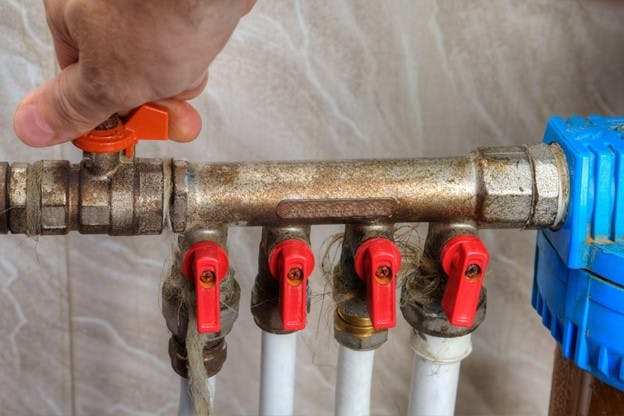Efficient Approaches for Dealing with Low Water Pressure in Your Home
Efficient Approaches for Dealing with Low Water Pressure in Your Home
Blog Article
Everybody maintains their unique conception when it comes to 4 Ways to Troubleshoot Low Water Pressure.

Low water stress in your house can be a discouraging problem, affecting every little thing from showering to cleaning dishes. If you're experiencing weak water flow, there are a number of feasible reasons and options to discover. In this overview, we'll discuss common factors for low water stress and sensible actions to deal with the problem properly.
Intro to Low Tide Pressure
Low water stress happens when the flow of water from your taps, showers, and other fixtures is weaker than usual. This can make everyday tasks extra challenging and less efficient. Recognizing the reasons for low water pressure is crucial to finding the ideal remedy.
Usual Causes of Low Tide Stress
Faulty Pressure Regulators
Stress regulators are in charge of preserving constant water pressure in your home. If they malfunction, it can result in low water stress or irregular flow throughout your home.
Local Water System Issues
Often, the problem exists outside your home. Local supply of water concerns, such as main line leaks or maintenance job, can temporarily minimize water stress in your location.
Pipeline Obstructions
Over time, pipes can end up being blocked with natural resource, debris, or debris, restricting the flow of water. This is a common issue in older homes with galvanized steel pipes.
Deterioration
Rust within pipes can result in leaks and decreased water stress. Rust buildup can constrict water flow, particularly in aging plumbing systems.
Just How to Detect Low Water Pressure
Evaluating Pipelines
Evaluate visible pipelines for indications of leaks, rust, or clogs. Take note of any kind of unusual audios, such as knocking or rattling pipelines, which might show issues within the plumbing system.
Consulting with a Plumber
If you're incapable to identify the source of low water stress, think about hiring a professional plumber to conduct a complete inspection. They can identify underlying concerns and recommend ideal options.
Examining Taps and Components
Begin by checking the water pressure at various faucets and components throughout your home. If the problem is separated to details areas, it might indicate local problems.
DIY Solutions to Repair Low Tide Pressure
Flushing Water Heater
Debris buildup in the water heater can limit circulation and lower performance. Flushing the storage tank occasionally helps eliminate sediment and preserve ideal performance.
Inspecting Pressure Regulator
Make certain that the stress regulatory authority is operating appropriately. Readjusting or replacing the regulator can help bring back correct water stress throughout your home.
Cleaning Aerators and Showerheads
Natural resources can accumulate in aerators and showerheads, reducing water circulation. Remove and cleanse these elements on a regular basis to boost water stress.
Clearing Up Clogs in Piping
For small blockages, try utilizing a plumbing serpent or chemical drainpipe cleaner to clear blockages in pipes. Beware when utilizing chemicals and follow safety and security guidelines.
When to Call a Specialist Plumber
If DIY efforts stop working to solve the issue or if you presume substantial plumbing problems, it's best to seek support from a qualified plumber. They have the expertise and devices to deal with complex issues securely and properly.
Safety Nets to Preserve Water Stress
Setting Up a Stress Booster
Think about installing a pressure booster pump to boost water stress in areas with consistently reduced circulation. This can be particularly valuable for multi-story homes or residential properties with high-demand components.
Tracking Water Use
Bear in mind water use practices and stay clear of ill-using the plumbing system. Easy modifications, such as shocking showers and laundry loads, can assist preserve appropriate water stress.
Routine Maintenance
Schedule regular upkeep for your plumbing system to avoid problems such as corrosion, leakages, and obstructions. Resolving minor problems early can aid prevent more substantial fixings later.
Final thought
Dealing with low water stress can be discouraging, yet recognizing the underlying reasons and applying ideal services can bring back optimal circulation throughout your home. Whether it's cleaning up aerators, examining pipes, or speaking with a plumber, taking aggressive steps can make sure a constant supply of water for your daily needs.
FOUR WAYS TO FIX LOW WATER PRESSURE NOW
Turning on a shower or faucet only to find the water comes out in a sad, slow drizzle is never a good feeling. How exactly are you supposed to wash a pan or take a quick shower when it takes 10 minutes just to rinse off a little soap? The good news is that when your water pressure is bad, there's always a cause: typically one that can be easily fixed. Here are some of the most common causes of low pressure and what you can do to fix the issue:
DEBRIS AND MINERAL DEPOSIT BUILDUPS
If you notice low water pressure from just one or two of the fixtures in your house, the problem likely has to do with debris buildup. Water is full of minerals and other debris, all of which can accumulate in your pipes and on your fixtures. This can cause a blockage that affects how much water flows through. To fix this, try filling a small plastic bag with white vinegar, and use a rubber band to hang it around your showerhead or faucet. Let the head of the fixture soak for a few hours, and the vinegar should loosen the deposits.
WATER LEAKS
Leaks are another common cause of low water pressure. If water is flowing out of your plumbing through a hole or crack before it can reach your fixture, the pressure coming out of the faucet or showerhead will be lower. A plumbing professional is your best bet for finding and repairing a leak in your water supply pipes.
Leaks are another common cause of low water pressure. If water is flowing out of your plumbing through a hole or crack before it can reach your fixture, the pressure coming out of the faucet or showerhead will be lower. A plumbing professional is your best bet for finding and repairing a leak in your water supply pipes.
A VALVE ISSUE
If you have low water pressure throughout your home, check your main shut-off valve to make sure it's completely open. You may also want to see if there's a pressure-reducing valve installed. If there is, have a plumber help you adjust the settings to get the pressure you're looking for.
OTHERS USING WATER
Believe it or not, your low water pressure could be caused by your neighbors. If you notice low pressure at certain times of day, it may be because you and the people living next to you have similar schedules - when everyone is showering at the same time, the pressure will be lower in every home. Low pressure throughout the neighborhood may also be caused by an issue with your municipal water supply. If that's the case, call the supplier to see if they're working on the issue.
https://www.rotorooter.com/blog/water-leaking/low-water-pressure-fixes/

As an avid person who reads about , I thought sharing that piece of writing was essential. Do you know about another person who is interested in the subject? Please feel free to promote it. I truly appreciate reading our article about 9 Reasons for Low Water Pressure in Your House.
Call Report this page